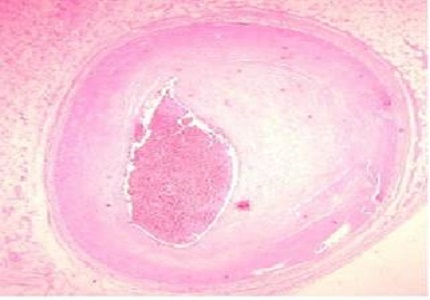Neovascularization in Advanced Atherosclerosis - A Histomorphometric Study
Abstract
Introduction: Neovascularization is an important component of advanced atherosclerosis which leads to plaque vulnerability and rupture. This is an endarterectomy study where neovascularization is quantified in 50 advanced atherosclerotic plaques by using IHC stain and measuring the positivity by histomorphometry, simultaneously assessing lipid pool area and fibrous cap thickness (average and minimum), also by histomorphometry. The values were compared across different AHA types and also probable vulnerable plaques were identified.
Materials & Methods: Three heart specimens obtained at autopsy from subjects who died of RTA showed evidence of coronary artery disease on post-mortem coronary angiogram. Coronary endarterectomy was done from these specimens and was made into tissue blocks for histological study. On H& E sections the plaques were classified by AHA typing and 50 advanced atherosclerotic plaques were chosen for this study. To assess neovascularization, the IHC stain CD34 was used and the percentage area of positivity was later measured using histomorphometry. The lipid pool area in the plaques and the fibrous cap thickness were also measured using histomorphometry.
Results: In our study, 47 out of 50 advanced lesions showed neovascularization although the difference in their amounts between AHA Type IV and V was not statistically significant. On measuring lipid pool area and fibrous cap thickness, we found 4 of the 50 plaques to be probable vulnerable plaques as they had a combination of a large lipid pool (>40% of the plaque area) and a thin fibrous cap (<65μ) in addition to revascularization.
Conclusion: This study showed that neovascularization was seen in most of the advanced atherosclerotic plaques and together with some other features like large lipid pool and thin fibrous cap, it can potentially make a plaque vulnerable to rupture. The understanding of role of neovascularization in plaque rupture has led to the trial of antiangiogenic therapy to prevent plaque progression.
Downloads
References
2. Herrmann J, Lerman A. Atherosclerosis in the back yard. J Am Coll Cardiol. 2007 May 29; 49(21):2102-4. Epub 2007 May 17. [PubMed]
3. Coghill SB, Nicoll SM, McKimmie A, Houston I, Matthew BM. Revitalising postmortem coronary angiography. J Clin Pathol. 1983 Dec;36(12):1406-9. doi:10.1136/jcp.36.12.1406. [PubMed]
4. Stary HC, Chandler AB, Glagov S, Guyton JR, Insull, Jr, W, Rosenfeld ME, Schaffer SA, Schwartz CJ, Wagner WD, Wissler . A definition of initial, fatty streak, and intermediate lesions of atherosclerosis. A report from the Committee on Vascular Lesions of the Council on Arteriosclerosis, American Heart Association. Circulation 1994 May;89(5):2462-78. doi: 10.1161/01.CIR.89.5.2462.
5. Stary HC, Chandler AB, Dinsmore RE, Fuster V, Glagov S, Insull, Jr, W, Rosenfeld ME, Schwartz CJ, Wagner WD, Wissler RW. Definition of Advanced Types of Atherosclerotic Lesions and a Histological Classification of Atherosclerosis. Circulation 1995; 92:1355-1374. doi: 10.1161/01.CIR.92.5.1355.
6. Naghavi M, Libby P, Falk E, Casscells SW, Litovsky S, Rumberger J, et al. From Vulnerable Plaque to Vulnerable Patient: A Call for New Definitions and Risk Assessment Strategies: Part I. Circulation 2003;108(15):1664-1672. doi: 10.1161/01.CIR.0000087481.55887.C9.
7. Virmani R, Kolodgie FD, Burke AP, Farb A, Schwartz SM. Lessons From Sudden Coronary Death: A Comprehensive Morphological Classification Scheme for Atherosclerotic Lesions. Arterioscler Thromb Vasc Biol. 2000 May;20(5):1262-1275. doi: 10.1161/01.ATV.20.5.1262.
8. Fleiner M, Kummer M, Mirlacher M, Sauter G, Cathomas G, Krapf R, Biedermann BC. Arterial neovascularization and inflammation in vulnerable patients: early and late signs of symptomatic atherosclerosis. Circulation. 2004 Nov 2;110(18):2843-50. Epub 2004 Oct 25.
9. Stary HC, Blankenhorn DH, Chandler AB, Glagov S, Insull, Jr, W, Richardson M, Rosenfeld ME, Schaffer SA, Schwartz CJ, Wagner, Jr, WD, Richardson M. A definition of the intima of human arteries and of its atherosclerosis- prone regions. A report from the Committee on Vascular Lesions of the Council on Arteriosclerosis, American Heart Association. Circulation 1992 Jan;85(1):391-405. doi:10.1161/01.CIR.85.1.391.
10. Doyle B, Caplice N. Plaque neovascularization and antiangiogenic therapy for atherosclerosis. J Am Coll Cardiol. 2007 May 29;49(21):2073-80. Epub 2007 May 17. [PubMed]
11. Kolodgie FD, Gold HK, Burke AP, Fowler DR, Kruth HS, Weber DK, Farb A, Guerrero LJ, Hayase M, Kutys R, Narula J, Finn AV, Virmani R. Intraplaque hemorrhage and progression of coronary atheroma. N Engl J Med. 2003 Dec 11;349(24):2316-25. doi: 10.1056/NEJMoa035655. [PubMed]
12. Packard RR, Libby P. Inflammation in atherosclerosis: from vascular biology to biomarker discovery and risk prediction. Clin Chem. 2008 Jan;54(1):24-38. [PubMed]
13. Moreno PR, Purushothaman KR, Fuster V, Echeverri D, Truszczynska H, Sharma SK, Badimon JJ, O’Connor WN. Plaque Neovascularization Is Increased in Ruptured Atherosclerotic Lesions of Human Aorta Implications for Plaque Vulnerability. Circulation 2004 Sep;110(14):2032-2038. doi: 10.1161/01.CIR.0000143233.87854.23.



 OAI - Open Archives Initiative
OAI - Open Archives Initiative


